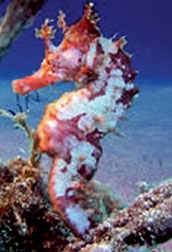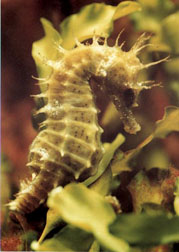|
observer |
|
|
|
|
|
OTHER LINKS |

|

|

|
|
|
|
|
It may be confusing as to how one animal could have all these features of different types of animals and still function without any difficulty; each of these special features play an important role for the smooth existence of the sea horse.
For instance, the binocular vision helps the sea horse to keep watch on an enemy with one eye, while hunting for food with the other. The tube-shaped snout, which is actually its mouth, is designed to suck up prey. The snout or the mouth, has an upper and lower jaw, both of which are toothless!
The monkey-like tail is like a lifeline to the tiny sea horse who could easily be swept away by the strong currents of the sea. It avoids being washed away by anchoring itself to sea weeds and plants, with its tail.
Then, the armour plate, which consists of bony plates that interlock through the entire body, and is arranged in rings, and the spines that mark these interlocking joints, give the sea horse protection from its enemies. Its power to camouflage itself by changing colour in the blink of an eye is a great defence against its enemies, which are many. Humans are also their enemies, as some eat them.
Anatomy - It has a coronet which is nearly as distinctive as a human thumbprint, pectoral fins which control steering and turning, and transparent fins on the back called dorsal fins which help the sea horse to move forward.
These dorsal fins beat so fast, about 20-30 times per second, that we can't see them. Unlike other fish, the sea horse does not have caudal or tail fins. However, it moves or rather glides majestically, in up and down movements which it regulates by controlling the volume of gas in the body. Sea horses come in a range of colours - from white, yellow, red, brown, black, grey to spotted or banded.
Diet and enemies
 Sea horses prey on microscopic creatures such as small crustaceans,
brine shrimp, plankton and worms. Even though they are toothless, they
consume as much as 3,000 brine shrimp a day by swallowing them whole!
Sea horses prey on microscopic creatures such as small crustaceans,
brine shrimp, plankton and worms. Even though they are toothless, they
consume as much as 3,000 brine shrimp a day by swallowing them whole!
Guess who preys on them, while they prey on other tiny creatures? Large fish, birds, crabs and turtles of course. Apart from the colour changing to blend with the background, another method of camouflage they use to escape these enemies is growing skin appendages (additions) to blend in better with the algae around them.
The head and eye are well hidden by the organisms on the sea horse. As these creatures are weighed down by the armour plates, they have limited flexibility and are poor swimmers too. So, they have to resort to camouflage tricks to survive for another day!
Reproduction and parental care
Here's another unique feature of these fascinating sea creatures. You may be aware that when it comes to mammals, mostly the females provide parental care. In birds, both usually share the responsibility, but in fish, most often, the males get landed with the responsibility. In the case of sea horses too, it's the males who become super dads!
Unlike in most species of fish, where the males generally guard the eggs, fan them, keep them clean and ensure they have enough oxygen and so on, sea horses take their role of being dads even further.
They not only guard the eggs inside the body, but also sustain the young inside and give birth to them. Male sea horses become 'pregnant' when a female lays her eggs in what is known as the brood pouch.
Remember the kangaroo pouch we mentioned earlier? The female lays between 200-600 eggs which are pinkish in colour and are nothing more than .5 to 1.5 mm in size. Even though the male and female sea horse stay partners for life, it's the dad who makes sure that the baby sea ponies are born safely.
It ensures that the eggs that are placed in its pouch get sufficient oxygen through a capillary network in the pouch, transfers nutrients for the babies to grow and controls the pouch environment for a healthy growth. However, once the sea ponies are born in about 2-3 weeks time, they are left to fend for themselves. I guess enough is enough for this super dad, who is even believed to experience birth pains!
Anyway, it does not seem as if the males get much of a break to stay free of pregnancy because they are known to be impregnated again almost right away after one clutch of eggs are hatched.
Species, habitat and lifespan
Around 35-40 species of this unique vertebrate fish have been identified in warm, temperate salt waters off the coast of Australia and the US. They make their homes in reefs and seaweed and are typically found in depths between 5-30 metres.
Four species found around North America to South America range in sizes from very small (Dwarf sea horse), which is about an inch upto around a foot (Hippocampus ingens).Some of the other species are the Big belly sea horse, Giraffe sea horse, Tiger tail sea horse, Bull neck, Japanese sea horse, West African sea horse and the Yellow or Thorny sea horse.
Well, now that you've learnt so much about these tiny but unique sea creatures, why don't you make an attempt to see them alive at an aquarium, perhaps at the national zoo?


 Are these tiny, unique creatures real, or, as the ancient mariners
who first spotted them thought, the offspring of the Roman god of the
sea, Neptune? Some of you who may have never seen them even in pictures,
leave alone at an aquarium, may find it hard to believe that there are
such creatures in the sea.
Are these tiny, unique creatures real, or, as the ancient mariners
who first spotted them thought, the offspring of the Roman god of the
sea, Neptune? Some of you who may have never seen them even in pictures,
leave alone at an aquarium, may find it hard to believe that there are
such creatures in the sea. 








